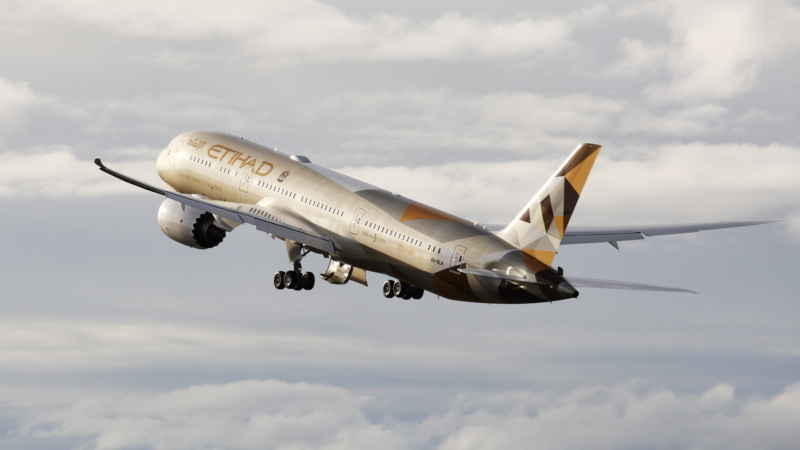Driving efficiency through smarter working
25 June 2015Smarter and more collaborative working is the best way to be efficient and ensure we can be sustainable as an industry. And that’s why NATS partners with other aviation leaders on environmental projects and alliances.
Recently, NATS worked with 30 aviation organisations, including civil aviation authorities, airports, ground service providers and air navigation providers, to help Etihad Airways perform their most fuel-efficient ‘Perfect Flight’ involving a Boeing 787 Dreamliner flying from Abu Dhabi to Washington DC and back.

Helping Etihad achieve perfect flights – here is the outbound journey ETD131 in Shanwick Oceanic area
For NATS’ sections of the flights, designed specific procedures to prepare the operation to assist as much as possible to ensure a smooth transition throughout its journeys – both inbound and outbound. While the flight operated within the Shanwick Oceanic area and the London FIR airspace, NATS ATCOs gave direct track routings and ensured that levels requested by the flight were made available.
By maximising efficiency opportunities on the route and altitude selection, the 11,000km flight, which took 13 hours and 32 minutes saved the airline an estimated 4,100 litres of fuel, 10.7 tonnes of carbon emissions and eight minutes of the journey time, compared to the same aircraft flying a normal flight plan.
The collaborative effort was led by Etihad Airways, and involved Abu Dhabi Airport, Abu Dhabi Department of Transport (DoT), General Civil Aviation Authority (GCAA) and Global Aerospace Logistics – ANS, as well as international partners Boeing, Eurocontrol, the US Federation Aviation Authority (FAA), Finavia, Irish Aviation Authority, Isavia, Jeppesen, Metropolitan Washington Airports Authority, NATS and NAV CANADA.
This is just one example of how the industry is successfully taking steps to optimise efficiency and reduce its carbon footprint. And we need to keep it up.
NATS has previously worked with airlines to perform a number of ‘perfect flights’, as well as implementing a number of changes to our processes and introducing innovative technology to ensure we’re working towards a sustainable future for the aviation industry. We learn a huge amount about airspace efficiency from these trials, and that learning then informs how we develop and modernise airspace for the future.
Our recently published Corporate Responsibility Report 2014-15 outlines a number of projects we’ve been working on to reduce CO2 and fuel burn.
Another example of NATS’ collaborative work to reduce environmental impacts of flights under our control was the cross border arrival (XMAN) trial at Heathrow Airport. Since April 2014, NATS has recorded a reduction of up to a minute in airborne holding times for flights in the trial, saving airlines over £1 million in fuel costs and reducing CO2 emissions by 7,000 tonnes.
The XMAN trial saw controllers in the UK, France, Ireland and the Netherlands working together to slow aircraft down up to 350 nautical miles away from London in order to minimise airborne holding times approaching Heathrow. This is the first step of a broader strategy to decrease the amount of time aircraft spend in airborne holding patterns at the airport.
Also as part of the Sustainable Aviation coalition, industry leaders, such as airlines, airports and manufacturers, have been working closely to increase the use of continuous descent operations (CDO) at around 23 airports, to save fuel and reduce airlines’ CO2 emissions, while also reducing noise for flights around airports. Through this collaboration more than 39,000 additional quieter flights were achieved through CDO, from its launch in July 2014 to April 2015.
In the last financial year NATS has improved a number of its efficiency measures to reduce the average ATM related CO2 emissions per flight by 4.3%, compared to flights in 2006. This successfully exceeded our 4% target for 2014.
Last year also saw NATS adopt the use of near real time airspace efficiency monitoring using an in-house developed tool called Flight Optimisation System – or FLOSYS.
Using real radar data and combining it with NATS’ 3Di airspace efficiency metric, it produces a graphical representation of every flight in UK airspace so our controllers can immediately review performance and identify areas for improvement, or best practice techniques to share.
The drive towards sustainability in the aviation sector is well underway and there is certainly more to do. But one thing is certain, collaboration like this will help us deliver more environmentally efficient flight sooner, and quicker than working alone.
Comments
Please respect our commenting policy and guidelines when posting on this website.

